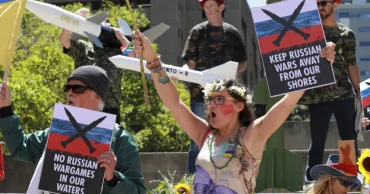drills
US, Filipino forces show power in drills amid China tensions
Thousands of American and Filipino forces pummeled a ship with a barrage of high-precision rockets, airstrikes and artillery fire in their largest war drills on Wednesday in Philippine waters facing the disputed South China Sea that would likely antagonize China.
President Ferdinand Marcos Jr. watched the American show of firepower from an observation tower in the coastal town of San Antonio in northwestern Zambales province — the latest indication of his strong backing of the Philippines' treaty alliance with the U.S.
Marcos has ordered his military to shift its focus to external defense from decades-long anti-insurgency battles as China’s increasingly aggressive actions in the South China Sea become a top concern. The shift in the Philippine defense focus falls in sync with the Biden administration’s aim of reinforcing an arc of alliances in the Indo-Pacific region to better counter China.
Also Read: US sails warship through Taiwan Strait after China's drills
China has angered the Philippines by repeatedly harassing its navy and coast guard patrols and chasing away fishermen in the waters close to Philippine shores but which Beijing claims as its own. The Philippines has filed more than 200 diplomatic protests against China since last year, including at least 77 since Marcos took office in June.
Sitting beside U.S. Ambassador MaryKay Carlson and his top defense and security advisers, Marcos used a pair of binoculars, smiling and nodding, as rockets streaked into the blue sky from the U.S. High Mobility Artillery Rocket System, or HIMARS, a multiple rocket and missile launcher mounted on a truck that has become a crucial weapon for Ukrainian troops battling Russian invasion forces.
The coastal clearing in front of Marcos resembled a smoke-shrouded war zone, which thudded with artillery fire as AH-64 Apache attack helicopters flew overhead.
Also Read: US, Philippines hold largest war drills near disputed waters
“This training increased the exercise’s realism and complexity, a key priority shared between the Armed Forces of the Philippines and the U.S. military,” Lt. Gen. William Jurney, commander of U.S. Marine Corps Forces, Pacific, said.
“Together we are strengthening our capabilities in full-spectrum military operations across all domains,” said Jurney, the U.S. director for the annual joint exercises called Balikatan, Tagalog for ”shoulder-to-shoulder."
About 12,200 U.S military personnel, 5,400 Filipino forces and 111 Australian counterparts were taking part in the exercises, the largest since Balikatan started three decades ago. The drills have showcased U.S. warships, fighter jets as well as Patriot missiles, HIMARS and anti-tank Javelins, according to U.S. and Philippine military officials.
The ship targeted by the allied forces was a decommissioned Philippine navy warship, which was towed about 18 to 22 kilometers (11 to 14 miles) out to sea.
Smaller floating targets, including empty drums tied together, were also used as targets to simulate a battle scene where a U.S. Marine Corps command and control hub enabled scattered allied forces to identify and locate enemy targets then deliver precision rocket and missile fire.
Philippine military officials said the maneuvers would bolster the country’s coastal defense and disaster-response capabilities and were not aimed at any country. China has opposed military drills involving U.S. forces in the region in the past as well as increasing U.S. military deployments, which it warned would rachet up tensions and hamper regional stability and peace.
Washington and Beijing have been on a collision course over China’s increasingly assertive actions to defend its vast territorial claims in the South China Sea and Beijing’s goal of annexing Taiwan, by force if necessary.
In February, Marcos approved a wider U.S. military presence in the Philippines by allowing rotating batches of American forces to stay in four more Philippine military camps. That was a sharp turnaround from his predecessor Rodrigo Duterte, who feared that a larger American military footprint could antagonize Beijing.
China strongly opposed the move, which would allow U.S. forces to establish staging grounds and surveillance posts in the northern Philippines across the sea from Taiwan and in western Philippine provinces facing the South China Sea, which Beijing claims virtually in its entirety.
China has warned that a deepening security alliance between Washington and Manila and their ongoing military drills should not harm its security and territorial interests or interfere in the territorial disputes.
The Chinese Foreign Ministry has said that such military cooperation “should not target any third party and should be conducive to regional peace and stability.”
2 years ago
Russia to test new hypersonic missile in drills with China and South Africa
Russia, China and South Africa are set to begin naval drills off South Africa’s Indian Ocean coast Friday in a demonstration of the three countries’ close ties amid Russia’s invasion of Ukraine and China’s tense relationship with the West.
The 10 days of exercises, named Mosi II, will coincide with the first anniversary of Russia’s invasion of Ukraine on Feb. 24.
A Russian frigate, the Admiral Gorshkov, arrived in Cape Town earlier this week sporting the letters Z and V on its sides, letters that mark Russian weapons on the front lines in Ukraine and are used as a patriotic symbol in Russia.
In protest, a small yacht flying Ukraine’s flag sailed by the Russian frigate in Cape Town’s harbor. South African protesters opposed to the exercises are expected to demonstrate at the Russian Consulate in Cape Town on Friday.
The arrival of the Admiral Gorshkov has stirred considerable controversy because it is armed with the latest Zircon hypersonic missiles, a weapon that Russia says can penetrate any missile defenses to strike targets at sea and on land.
The warship is set to test-fire a Zircon missile during the joint naval drills, according to Russian state news agency Tass. The test will be the first launch of the missile in an international exercise.
In addition to the Admiral Gorshkov, other ships participating in the maritime exercises will include a Russian oil tanker for refueling, a South African frigate and three Chinese ships - a destroyer, a frigate and a support vessel, according to a South African military statement.
The joint naval exercises also come as China’s relations with Washington are tense after its balloon sailed across the U.S. and was eventually shot down by the U.S.
The maritime exercises will be staged from Durban and Richards Bay, ports in South Africa’s KwaZulu-Natal province.
Media coverage of the drills has been restricted.
South Africa has faced domestic criticism for participating in the drills. The opposition Democratic Alliance said it shows South Africa is not neutral in Russia’s war in Ukraine.
The South African National Defence Force has described the naval exercises with China and Russia simply as “a multinational maritime exercise.” The naval drills will “strengthen the already flourishing relations between South Africa, Russia and China” with the aim of sharing “operational skills and knowledge,” the military said in a statement.
At least 350 members of South Africa’s navy and other military branches are expected to participate in the exercise, the government has said.
The three countries previously held the Mosi I naval drills in Cape Town in 2019.
South Africa is among many African countries that have friendly relations with Moscow and abstained from voting on a United Nations resolution condemning Russia’s war in Ukraine.
Russia and the United States have courted support from South Africa since the war in Ukraine started, indicating Pretoria’s influence as a strategic partner on the continent. The two super powers have vied for influence in Africa, sending top officials on diplomatic missions to the continent in recent months.
High-ranking U.S. officials, including Secretary of State Antony Blinken and Treasury Secretary Janet Yellen, recently visited South Africa to deepen diplomatic, political and economic ties. South African President Cyril Ramaphosa visited the White House in September 2022.
During a visit to South Africa last month, Russian Foreign Minister Sergey Lavrov criticized the West’s actions in support of Ukraine and emphasized Russia’s strong ties with South Africa and other nations on the continent.
2 years ago
S. Korea says N. Korea fires missile as allies ready drills
South Korea’s military said North Korea on Saturday fired one suspected long-range missile from its capital toward the sea, a day after it threatened to take strong measures against South Korea and the U.S. over their joint military exercises.
The Joint Chiefs of Staff in Seoul said the ballistic missile was fired at around 5:22 p.m. from an area in Sunan, the site of Pyongyang's international airport. It didn't immediately say where the weapon landed.
North Korea’s Foreign Ministry on Friday threatened with "unprecedently" strong action against its rivals, after South Korea announced a series of planned military exercises with the United States aimed at sharpening their response to the North’s growing threats.
Toshiro Ino, Japan’s vice minister for defense, said the missile was expected have landed in waters within Japan’s exclusive economic zone, about 200 kilometers (125 miles) west of Oshima island. Oshima lies off the western coast of the northernmost main island of Hokkaido.
“We are doing our utmost, working closely with the U.S., to gain information, analyze and take appropriate vigilance and surveillance measures to protect the lives and property of our people,” he told reporters.
The launch was North Korea’s first since Jan. 1, when it test-fired a short-range weapon. It followed a massive military parade in Pyongyang last week, where troops rolled out more than a dozen intercontinental ballistic missiles as leader Kim Jong Un watched in delight from a balcony.
The unprecedented number of missiles underscored a continuation of expansion of his country’s military capabilities despite limited resources while negotiations with Washington remain stalemated.
Those missiles included a new system experts say is possibly linked to the North’s stated desire to acquire a solid-fuel ICBM. North Korea’s existing ICBMs, including Hwasong-17s, use liquid propellants that require pre-launch injections and cannot remain fueled for prolonged periods. A solid-fuel alternative would take less time to prepare and is easier to move around on vehicles, providing less opportunity to be spotted.
It wasn’t immediately clear whether Saturday’s launch involved a solid-fuel system.
“North Korean missile firings are often tests of technologies under development, and it will be notable if Pyongyang claims progress with a long-range solid-fuel missile,” said Leif-Eric Easley, a professor of international studies at Ewha Womans University in Seoul. “The Kim regime may also tout this launch as a response to U.S. defense cooperation with South Korea and sanctions diplomacy at the United Nations.”
North Korea is coming off a record year in weapons demonstrations with more than 70 ballistic missiles fired, including ICBMs with potential range to reach the U.S. mainland. The North also conducted a slew of launches it described as simulated nuclear attacks against South Korean and U.S. targets in response to the allies’ resumption of large-scale joint military exercise that had been downsized for years.
North Korea’s missile tests have been punctuated by threats of preemptive nuclear attacks against South Korea or the United States over what it perceives as a broad range of scenarios that put its leadership under threat.
Kim doubled down on his nuclear push entering 2023, calling for an “exponential increase” in the country’s nuclear warheads, mass production of battlefield tactical nuclear weapons targeting “enemy” South Korea and the development of more advanced ICBMs.
The North Korean statement on Friday accused Washington and Seoul of planning more than 20 rounds of military drills this year, including large-scale field exercises, and described its rivals as “the arch-criminals deliberately disrupting regional peace and stability.”
The statement came hours after South Korea’s Defense Ministry officials told lawmakers that Seoul and Washington will hold an annual computer-simulated combined training in mid-March. The 11-day training would reflect North Korea’s nuclear threats, as well as unspecified lessons from the Russia-Ukraine war, according to Heo Tae-keun, South Korea’s deputy minister of national defense policy.
Heo said the two countries will also conduct joint field exercises in mid-March that would be bigger than those held in the past few years.
South Korea and the U.S. will also hold a one-day tabletop exercise next week at the Pentagon to sharpen a response to a potential use of nuclear weapons by North Korea.
The exercise, scheduled for Wednesday, would set up possible scenarios where North Korea uses nuclear weapons, explore how to cope with them militarily and formulate crisis management plans, South Korea’s Defense Ministry said.
North Korea has traditionally described U.S.-South Korea military exercises as rehearsals for a potential invasion, while the allies insist that their drills are defensive in nature.
The United States and South Korea had downsized or canceled some of their major drills in recent years, first to support the former Trump administration’s diplomatic efforts with Pyongyang and then because of COVID-19. But North Korea’s growing nuclear threats have raised the urgency for South Korea and Japan to strengthen their defense postures in line with their alliances with the United States.
South Korea has been seeking reassurances that United States will swiftly and decisively use its nuclear capabilities to protect its ally in face of a North Korean nuclear attack. In addition to expanding and evolving military exercises with South Korea, the United States has also expressed commitment to increase its deployment of strategic military assets like fighter jets and aircraft carriers to the Korean Peninsula in a show of strength.
In December, Japan made a major break from its strictly self-defense-only post-World War II principle, adopting a new national security strategy that includes preemptive strikes and cruise missiles to counter growing threats from North Korea, China and Russia.
___
Associated Press writer Yuri Kageyama in Tokyo contributed to the report.
2 years ago
US holds drills in South China Sea amid tensions with China
The United States Navy and Marine Corps are holding joint exercises in the South China Sea at a time of heightened tensions with Beijing over the shooting down of a suspected Chinese spy balloon.
The 7th Fleet based in Japan said Sunday that the USS Nimitz aircraft carrier strike group and the 13th Marine Expeditionary Unit have been conducting “integrated expeditionary strike force operations” in the South China Sea.
It said exercises involving ships, ground forces and aircraft took place Saturday but gave no details on when the began or whether they had ended.
China claims virtually the entire South China Sea and strongly objects to military activity by other nations in the contested waterway through which $5 trillion in goods are shipped every year.
The U.S. takes no official position on sovereignty in the South China Sea, but maintains that freedom of navigation and overflight must be preserved. Several times a year, it sends ships sailing past fortified Chinese outposts in the Spratly Islands, prompting protests from Beijing.
The U.S. has also been strengthening its defense alliance with the Philippines, which has faced encroachment on islands and fisheries by the Chinese coast guard and nominally civilian but government-backed fleets.
The U.S. military exercises were planned in advance. They come as already tense relations between Washington and Beijing have been exacerbated by a diplomatic row sparked by the balloon, which was shot down last weekend in U.S. airspace off the coast of South Carolina.
The U.S. said the unmanned balloon was equipped to detect and collect intelligence signals, but Beijing insists it was a weather research airship that had accidently blown off course.
The balloon prompted Secretary of State Antony Blinken to abruptly cancel a high-stakes trip to Beijing aimed at easing tensions.
After first issuing a highly rare expression of regret over the balloon, China has toughened its rhetoric, calling the U.S. shootdown an overreaction and a violation of international norms. China's defense minister refused to take a phone call from U.S. Defense Secretary Lloyd Austin to discuss the matter.
The United States has since blacklisted six Chinese entities it said were linked to Beijing’s aerospace programs as part of its response to the incident. The House of Representatives also voted unanimously to condemn China for a “brazen violation” of U.S. sovereignty and efforts to “deceive the international community through false claims about its intelligence collection campaigns.”
The balloon was part of a large surveillance program that China has been conducting for several years, the Pentagon said. The U.S. says Chinese balloons have flown over dozens of countries across five continents in recent years, and it learned more about the balloon program after closely monitoring the one shot down near South Carolina.
In its news release, the 7th Fleet said the joint operation had “established a powerful presence in the region, which supports peace and stability."
“As a ready response force, we underpin a broad spectrum of missions including landing Marines ashore, humanitarian disaster relief, and deterring potential adversaries through visible and present combat power," the release said.
2 years ago
US, Indonesia, Australia hold drills amid China concerns
Soldiers from the U.S., Indonesia and Australia joined a live-fire drill on Friday, part of annual joint combat exercises on Sumatra island amid growing Chinese maritime activity in the Indo-Pacific region.
A total of more than 5,000 personnel from the U.S., Indonesia, Australia, Japan and Singapore are participating in this year’s exercises, making them the largest since they began in 2009.
The expanded drills are seen by China as a threat. Chinese state media have accused the U.S. of building an Indo-Pacific alliance similar to NATO to limit China’s growing military and diplomatic influence in the region.
The United Kingdom, Canada, France, India, Malaysia, South Korea, New Zealand, Papua New Guinea and East Timor also sent observers to the exercises, which began early this month.
The U.S. Indo-Pacific commander, Adm. John C. Aquilino Aquilino, said the 14 nations involved in the training are signaling their stronger ties as China grows increasingly assertive in claiming virtually the entire South China Sea and holds exercises threatening self-ruled Taiwan.
“The destabilizing actions by the People’s Republic of China as it applied to the threatening activities and actions against Taiwan is exactly what we are trying to avoid,” he said at a joint news conference with Indonesian military chief Gen. Andika Perkasa in Baturaja, a coastal town in South Sumatra province.
“We’ll continue to help deliver a free and open Indo-Pacific and be ready when we need to respond to any contingency,” Aquilino said.
Read: Taiwan says China military drills appear to simulate attack
Indonesia and China enjoy generally positive ties, but Jakarta has expressed concern about what it sees as Chinese encroachment in its exclusive economic zone in the South China Sea.
Despite its official position as a non-claimant state in the contested South China Sea, Indonesia has been “dragged along” in the territorial dispute since 2010 after China claimed part of Indonesia's exclusive economic zone in the northern region of the Natuna Islands, said Connie Rahakundini Bakrie, a security analyst at the University of Indonesia.
The edge of the exclusive economic zone overlaps with Beijing’s unilaterally declared “nine-dash line” demarking its claims in the South China Sea.
Increased activities by Chinese coast guard vessels and fishing boats in the area have unnerved Jakarta, prompting Indonesia's navy to conduct a large drill in July 2020 in waters around Natuna at the southern portion of the South China Sea.
Indonesia sees the current exercises with the U.S. as a deterrent in defense of the Natuna Islands, while for Washington, the drills are part of efforts to forge a united front against China’s military buildup in the South China Sea, Bakrie said.
"Indonesia wants to send the message that it is fully prepared for any high-intensity conflict in the South China Sea area,” she said.
The joint combat exercises end Sunday.
3 years ago









